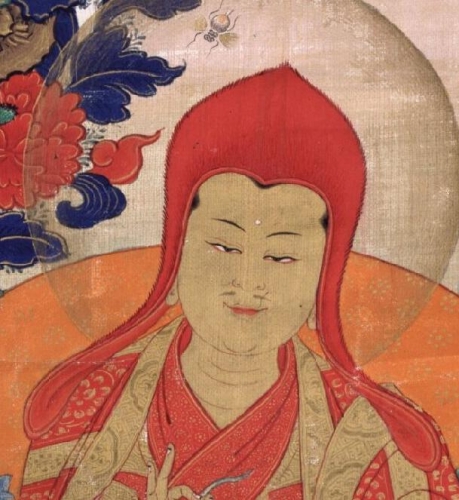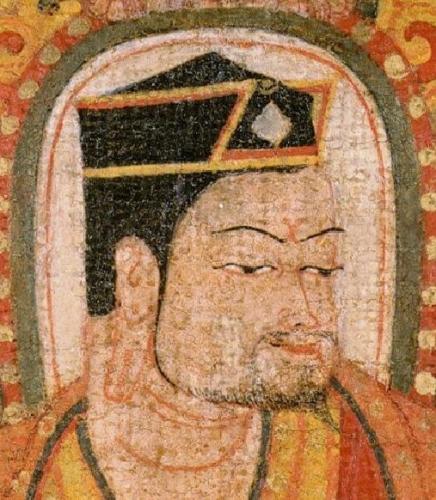Buddhist practice and Buddhist art have been inseparable in the Himalayas ever since Buddhism arrived to the region in the eighth century. But for the casual observer it can be difficult to make sense of the complex iconography. Not to worry—Himalayan art scholar Jeff Watt is here to help. In this “Himalayan Buddhist Art 101” series, Jeff is making sense of this rich artistic tradition by presenting weekly images from the Himalayan Art Resources archives and explaining their roles in the Buddhist tradition.
This week Jeff examines the four styles of hats in religious paintings.
Himalayan Buddhist Art 101: Hats in Religious Paintings
Hats are one of the most unique and interesting features of Himalayan and Tibetan art. They are also the most important item to look for when trying to identify religious teachers in paintings and sculpture. Buddhism and Bon have their own distinct hats, and there is an almost endless variety of colors, shapes,  and styles. Luckily for the novice iconographer and student of religious traditions, the hats can be easily separated into four basic styles.
and styles. Luckily for the novice iconographer and student of religious traditions, the hats can be easily separated into four basic styles.
The oldest and most common style of hat is the Pandita hat, believed to have originated in India. The hat is round in shape and tapers upward to either a small or steep point. It covers the ears at the sides with long lappets which hang down over the shoulders. The hat is common to all of the various Buddhist traditions and schools. Generally it is only worn by monks and signifies an advanced level of education. This hat is the principle head covering of the Sakya, Shangpa, Jonang, and Gelug traditions. In recent centuries the Sakya tradition has adopted the convention of folding the lappets upward and and over the crown of the hat, creating a triangular banded appearance. For most traditions the hat is typically red, though the Gelug tradition uses a yellow Pandita hat borrowed from the preferred style of Shalu monastery.
The second style is the Lotus hat made famous by Padmasambhava, one of the three popularly credited founders of Buddhism in  Tibet. This hat is similar to the Pandita hat in basic shape but without the lappets. The sides of the multi-colored hat are folded up and the garment is decorated with ornate ribbons and a half vajra ornament at the top, and some have a bird feather above the vajra. The Lotus is the principal hat of the Nyingma tradition and can be worn by either monks or lay teachers. There are many varieties of Lotus hat, some are small and some are very large with a variety of ornamentation depending on the particular Nyingma tradition. The Payul branch of Nyingma has a unique Lotus hat that can be identified by the long lappets that hang down over the shoulders.
Tibet. This hat is similar to the Pandita hat in basic shape but without the lappets. The sides of the multi-colored hat are folded up and the garment is decorated with ornate ribbons and a half vajra ornament at the top, and some have a bird feather above the vajra. The Lotus is the principal hat of the Nyingma tradition and can be worn by either monks or lay teachers. There are many varieties of Lotus hat, some are small and some are very large with a variety of ornamentation depending on the particular Nyingma tradition. The Payul branch of Nyingma has a unique Lotus hat that can be identified by the long lappets that hang down over the shoulders.
 The third style is the Fan-like hat popularized by Gampopa Sonam Rinchen. The hat is tall and very broad like a fan with wide lappets that hang down on the sides and extend almost to the shoulders. Often the lappets are folded upward creating an even more fan-like appearance. The hats are almost always red and are the principal head attire of most of the Kagyu traditions, except for the Karma Kagyu. Fan-like hats are not generally found with any of the other Buddhist tradition and remain unique to the Dagpo Kagyu traditions descending from Gampopa.
The third style is the Fan-like hat popularized by Gampopa Sonam Rinchen. The hat is tall and very broad like a fan with wide lappets that hang down on the sides and extend almost to the shoulders. Often the lappets are folded upward creating an even more fan-like appearance. The hats are almost always red and are the principal head attire of most of the Kagyu traditions, except for the Karma Kagyu. Fan-like hats are not generally found with any of the other Buddhist tradition and remain unique to the Dagpo Kagyu traditions descending from Gampopa.
The fourth style is the Cap, and just as caps in the West are generally small and just cover the top of the head, so it is with the  Tibetan cap. The small size and lack of excessive ornamentation or side flaps define the Cap style. Caps are the principal head attire of the Karma Kagyu tradition of Tibetan Buddhism. The most famous cap is the black hat worn by the Karmapa line of teachers. From the time of the 5th Karmapa there have been two styles of black hat: a simple traditional hat and and a very ornate black hat. Other caps of the Karma Kagyu include the red hat worn by the Shamarpa, and the red, orange, and green speckled hats worn by other ranked teachers. Caps are also worn by other Kagyu traditions, and sometimes by members of the Nyingma, Sakya and Jonangs traditions, but to a much lesser degree than in the Karma Kagyu tradition.
Tibetan cap. The small size and lack of excessive ornamentation or side flaps define the Cap style. Caps are the principal head attire of the Karma Kagyu tradition of Tibetan Buddhism. The most famous cap is the black hat worn by the Karmapa line of teachers. From the time of the 5th Karmapa there have been two styles of black hat: a simple traditional hat and and a very ornate black hat. Other caps of the Karma Kagyu include the red hat worn by the Shamarpa, and the red, orange, and green speckled hats worn by other ranked teachers. Caps are also worn by other Kagyu traditions, and sometimes by members of the Nyingma, Sakya and Jonangs traditions, but to a much lesser degree than in the Karma Kagyu tradition.
A knowledge of the different styles of hats is an essential tool in the study of Buddhist iconography. Recognizing the hats of Tibetan teachers is the most important key to identifying the different religious traditions and individual figures in traditional paintings.
For more on hats of the Himalayas, click here.
Thank you for subscribing to Tricycle! As a nonprofit, we depend on readers like you to keep Buddhist teachings and practices widely available.